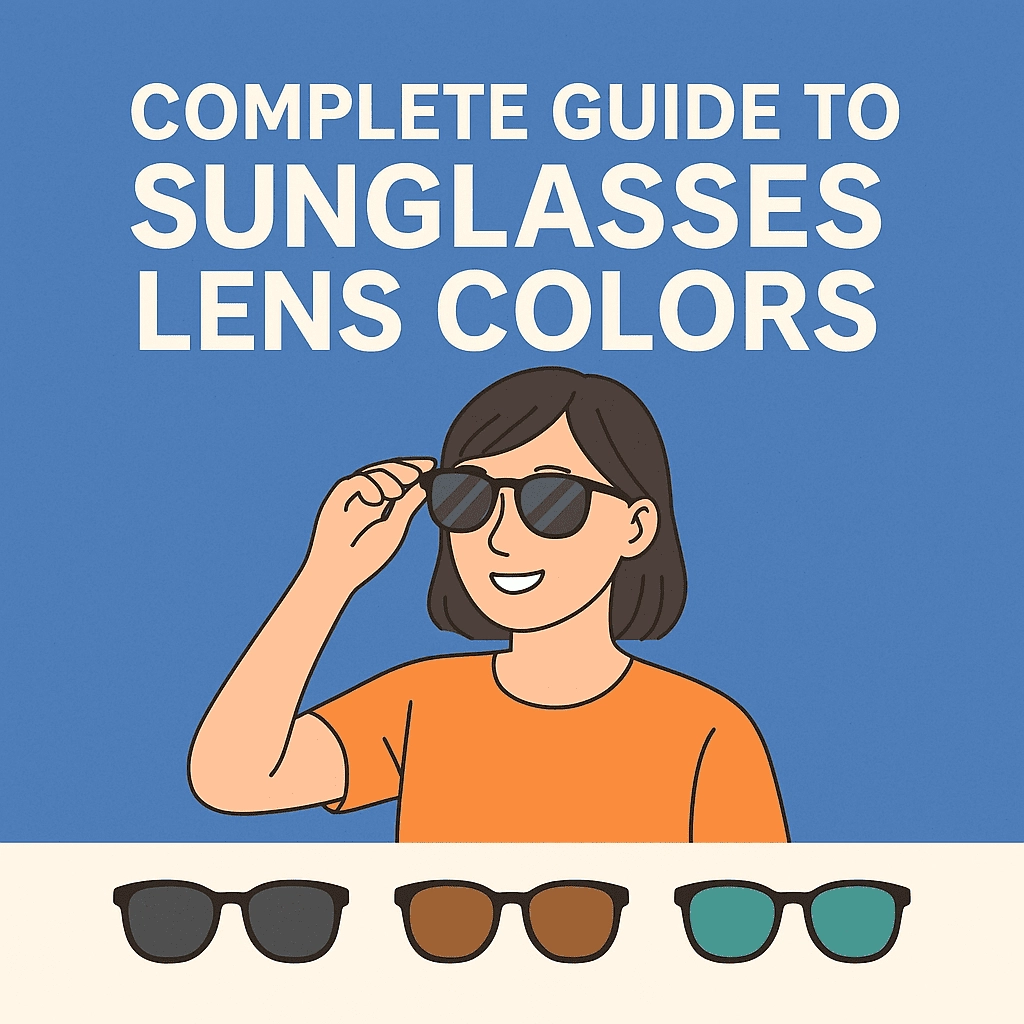When choosing sunglasses, one of the most important decisions you’ll make is selecting the right lens color. The lens color you choose can have a significant impact on your comfort, visual clarity, and even your overall experience while outdoors. From reducing glare to improving contrast, the right sunglasses lens color can enhance your performance in various activities. This guide explores the most popular sunglasses lens colors and their specific benefits, helping you make an informed decision for your eyewear needs.

1. Why Is Choosing the Right Sunglasses Lens Color Important?
Sunglasses lens color plays a crucial role in enhancing both your comfort and safety in different environments. What’s the real story? Well, the lens color impacts your ability to see clearly, block harmful UV rays, and reduce glare, all of which are critical for eye health and overall comfort. For instance, lens colors like brown and gray are designed to reduce brightness and contrast, making them perfect for sunny days. But here’s the kicker… lens color also affects the sharpness of your vision, especially in specific conditions like driving or sports.
Beyond comfort, choosing the right lens color is essential for protecting your eyes. Sunglasses with the correct lens color help filter out harmful blue light and UV rays, reducing the risk of long-term eye damage. So, understanding how each color affects your eyes and vision is vital for making the best choice.
Benefits of the Right Lens Color
| Benefit | Description |
|---|---|
| Reduces Glare | Enhances comfort by reducing brightness. |
| Improves Contrast | Provides sharper, clearer vision in different light conditions. |
| Protects Eyes | Blocks harmful UV rays and blue light to reduce long-term damage. |
| Enhances Performance | Improves visual clarity for specific activities like sports or driving. |
2. What Are the Most Common Sunglasses Lens Colors?
When you start shopping for sunglasses, you’ll encounter a variety of lens colors, each offering specific advantages. What’s the real story? Lens colors can dramatically change the way you see the world around you, offering both functional and aesthetic benefits. Ready for the good part? Let’s break down the most common lens colors and the unique benefits each one offers:
| Lens Color | Benefits | Best For |
|---|---|---|
| Brown/Amber | Enhances contrast, reduces glare | Driving, hiking, fishing |
| Gray | Reduces brightness without distorting colors | Bright, sunny days |
| Yellow/Gold | Improves contrast in low-light conditions | Cloudy or overcast weather |
| Blue/Pink | Enhances contrast, provides a stylish look | Fashion, general use |
| Green | Reduces glare, improves contrast without distorting colors | General use, outdoor activities |
3. How Do Different Lens Colors Affect Visual Clarity?
The color of your sunglasses lenses can significantly impact how clearly you see. What’s the real story? Some colors are better suited for enhancing visual clarity in bright sunlight, while others are designed to improve contrast and sharpness in low-light environments. Here’s the kicker… each lens color has a specific purpose, and understanding how they work can help you choose the best option for your needs.
| Lens Color | Visual Clarity Benefit | Best Use Case |
|---|---|---|
| Brown Lenses | Enhances contrast and depth perception | Outdoors in bright sunlight |
| Gray Lenses | Reduces overall brightness without distorting colors | Driving, sunny days |
| Yellow Lenses | Increases contrast, boosts clarity in low light | Cloudy, overcast weather, or night driving |
| Blue/Pink Lenses | Increases contrast, stylish option | Fashion and performance on sunny or cloudy days |
4. What Are the Best Sunglasses Lens Colors for Outdoor Sports?
If you’re an athlete or someone who spends a lot of time outdoors, the right lens color can improve your performance. But here’s the kicker… lens colors can impact your ability to see and react quickly, which is essential in high-intensity sports. What’s the real story? Certain lens colors are designed to enhance visual clarity, reduce glare, and boost contrast, all of which are crucial for outdoor activities.
| Sport | Best Lens Color | Benefit |
|---|---|---|
| Cycling/Mountain Biking | Brown/Amber | Enhances contrast, depth perception |
| Skiing/Snowboarding | Yellow/Gold | Improves contrast in low light, reduces glare from snow |
| Running/Hiking | Gray | Reduces glare, maintains color accuracy in bright light |
5. Which Lens Color Is Best for Driving?
Choosing the right lens color for driving is essential for reducing glare and improving road visibility. What’s the real story? Certain lens colors can make a world of difference when you’re behind the wheel, helping you stay safe by enhancing your vision. Ready for the good part? Let’s break down the best lens colors for driving:
| Lens Color | Driving Benefit | Ideal Conditions |
|---|---|---|
| Brown Lenses | Enhances contrast, reduces glare | Bright, sunny conditions |
| Gray Lenses | Reduces brightness, maintains natural color perception | Bright sunlight |
| Yellow Lenses | Improves contrast, enhances visibility | Low-light conditions, dawn, dusk |
6. What Role Does Lens Color Play in Protecting Your Eyes?
The primary role of sunglasses is to protect your eyes from harmful UV rays and glare. What’s the real story? Lens color not only affects how you see the world but also how well your sunglasses protect your eyes. Here’s the kicker… choosing the right lens color is key to blocking harmful light and preventing eye strain or long-term damage.
| Lens Color | Protection Benefit | UV Blocking |
|---|---|---|
| Brown Lenses | Blocks blue light, enhances contrast | High UV protection |
| Gray Lenses | Reduces glare, maintains natural color perception | Excellent UV protection |
| Yellow Lenses | Reduces eye strain, increases contrast | Moderate UV protection |
| Green Lenses | Reduces glare, maintains color balance | High UV protection |
7. Are There Any Lens Colors for Specific Weather Conditions?
Different lens colors are better suited for various weather conditions, from bright, sunny days to overcast, cloudy weather. What’s the real story? Lens color can help you see better in different lighting conditions, improving contrast and reducing glare. Ready for the good part? Let’s break it down:
| Weather Condition | Best Lens Color | Benefit |
|---|---|---|
| Sunny Days | Gray/Brown | Reduces brightness, enhances contrast |
| Cloudy/Overcast | Yellow/Gold | Increases contrast, boosts visibility |
| Variable Light | Photochromic | Adjusts to changing light conditions, ideal for fluctuating environments |
8. Can Sunglasses Lens Colors Improve Night Vision?
While sunglasses are primarily used for bright light, certain lens colors can improve your vision in low-light conditions, including at night. But here’s the kicker… if you’re someone who drives at night or participates in night sports, the right lens color can significantly enhance your ability to see clearly.
| Lens Color | Night Vision Benefit | Best Use Case |
|---|---|---|
| Yellow Lenses | Enhances contrast, improves visibility | Night driving, evening sports |
| Clear Lenses | Protects from UV rays while maintaining clarity | General protection without changing light perception |
| Red Lenses | Improves contrast, reduces glare | Night vision, optimal for driving and sports |
9. How Do Polarized Lenses Impact Sunglasses Lens Colors?
Polarized lenses are designed to reduce glare, but they can also enhance the benefits of certain lens colors. What’s the real story? Polarized lenses work by blocking out light that reflects off surfaces like water or roads, providing clearer vision and reducing eye strain. But here’s the kicker… when paired with specific lens colors, polarized lenses can significantly improve visual clarity in bright, reflective environments.
| Lens Color | Polarized Benefit | Ideal Use |
|---|---|---|
| Brown Lenses | Enhances contrast, reduces glare | Outdoor activities, driving |
| Gray Lenses | Reduces brightness, maintains color accuracy | General outdoor use, sports |
| Yellow Lenses | Improves contrast, reduces glare | Low-light conditions, driving |
10. Can I Customize My Sunglasses Lens Color?
If you’re looking for something more unique, many eyewear brands offer customization options for lens color. What’s the real story? Custom lenses allow you to select the perfect color for your needs, whether it’s for fashion or performance. Ready for the good part? Customization can give you full control over your sunglasses style.
| Customization Option | Available Lens Colors | Benefit |
|---|---|---|
| Classic Lenses | Brown, Gray, Yellow | Functional lenses for daily use |
| Fashion Lenses | Blue, Pink, Purple | Trendy colors for stylish looks |
| Photochromic Lenses | Brown, Gray, Yellow | Lenses that adjust to light changes |
11. What Are the Best Sunglasses Lens Colors for Fashion?
While functionality is important, sunglasses are also a fashion statement. What’s the real story? Lens color can have a significant impact on your overall look. But here’s the kicker… certain colors are on-trend and can help you make a bold statement.
| Lens Color | Fashion Impact | Ideal Occasions |
|---|---|---|
| Bold Colors (Blue/Pink) | Trendy, makes a statement | Fashion-forward, casual outings |
| Classic Colors (Brown/Gray) | Timeless, versatile | Everyday wear, formal events |
| Mirror Lenses | Sleek, reflective look | Outdoor events, fashion-forward |
12. How Do I Know Which Lens Color Works Best for My Eyes?
Choosing the right lens color can be challenging, especially with so many options available. What’s the real story? Your eyes are unique, and different lens colors may work better depending on your sensitivity to light and your lifestyle needs. Ready for the good part? Here are some tips for finding the perfect lens color for your eyes:
| Consideration | Recommended Lens Colors | Benefit |
|---|---|---|
| Light Sensitivity | Brown, Gray | Reduces brightness, glare |
| Activity Level | Yellow, Brown | Enhances contrast, depth perception |
| Eye Health | UV Protection Lenses | Blocks harmful UV rays |
13. Are There Any Sunglasses Lens Colors That Improve Sports Performance?
Sunglasses aren’t just for protection—they can also enhance your performance in sports. What’s the real story? Certain lens colors can improve your visual clarity and focus, which can give you an edge in athletic activities. Here’s the kicker… choosing the right color lens can be a game-changer for athletes.
| Sport | Recommended Lens Color | Performance Benefit |
|---|---|---|
| Golf | Brown/Amber | Enhances contrast and depth perception |
| Tennis | Yellow | Improves visibility and contrast during play |
| Water Sports | Polarized Gray | Reduces glare from water, improves clarity |
14. What Are the Benefits of Photochromic Lenses in Sunglasses?
Photochromic lenses, also known as transition lenses, adjust to changes in light intensity. What’s the real story? These lenses darken in bright light and clear up indoors, providing the perfect solution for people who move between different environments. Ready for the good part? They offer convenience and comfort without the need for multiple pairs of glasses.
| Benefit | Description |
|---|---|
| Convenience | No need for multiple pairs of glasses |
| UV Protection | Automatically adjusts to protect your eyes |
| Comfort | Lenses adjust to light changes, providing optimal visibility |
15. What Is the Conclusion About Sunglasses Lens Colors?
In conclusion, the lens color of your sunglasses plays an important role in your visual comfort, protection, and performance. What’s the real story? By understanding the different lens colors and their benefits, you can choose the right pair of sunglasses for your needs. Whether you’re looking for better contrast, glare reduction, or protection from UV rays, there’s a lens color that fits every activity. Remember, choosing the right lens can make a significant difference in your overall outdoor experience.
FAQ Section
Q1: What is the best lens color for sunglasses?
The best lens color depends on your specific needs and the activities you’ll be doing. Brown lenses are great for enhancing contrast and depth perception, while gray lenses are ideal for reducing glare in bright light. Yellow or gold lenses work well for low-light conditions and improving contrast.
Q2: How do lens colors affect eye comfort?
Different lens colors filter light in unique ways, improving eye comfort by reducing glare, enhancing contrast, and helping you see better in various light conditions. For example, brown lenses enhance contrast, while yellow lenses are excellent for low light conditions.
Q3: Can sunglasses lens color help with driving?
Yes, certain lens colors are ideal for driving as they improve contrast and reduce glare. Brown and gray lenses can enhance visibility on the road, while yellow lenses can improve contrast in low-light or overcast conditions.
Q4: Are polarized lenses necessary for all lens colors?
Polarized lenses are not required for all lens colors, but they can enhance the performance of certain lenses, particularly when dealing with glare. Polarization helps reduce surface glare from reflective surfaces like water and roads, making them essential for outdoor activities and driving.
Q5: Can I customize my sunglasses lens color?
Yes, many brands offer customization options for lens colors, allowing you to choose a lens color that suits your needs, whether it’s for fashion or function. Custom lenses can be made in various colors, such as brown, gray, or even unique shades to match your style.

